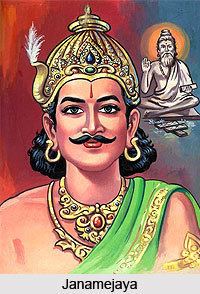Children Śatáníka | ||
 | ||
Similar Parikshit, Dhrishtadyumna, Satyaki, Barbarika | ||
Sri garikapati about janamejaya ekadasa skandam andhra mahabharatam episode 1776
Janamejaya (Sanskrit: जनमेजय) was a Kuru king who reigned during the Vedic period. Along with his predecessor Parikshit, he played a decisive role in the consolidation of the Kuru state, the arrangement of Vedic hymns into collections, and the development of the orthodox srauta ritual, transforming the Kuru realm into the dominant political and cultural center of northern Iron Age India.
Contents
- Sri garikapati about janamejaya ekadasa skandam andhra mahabharatam episode 1776
- Evidences says 5000 years ago sarpayaaga organised by king janamejaya in peruru medak
- In Vedic literature
- In Post Vedic Literature
- In Mahabharata
- Sarpa satra snake sacrifice
- References
Evidences says 5000 years ago sarpayaaga organised by king janamejaya in peruru medak
In Vedic literature
Janamejaya is mentioned as a great king and conqueror in a number of late Vedic texts. The Aitareya Brahmana (VIII.21) informs us that his priest Tura Kavasheya anointed him with the great anointing of Indra, and hence his descendants are called Tur. The Shatapatha Brahmana mentions that he performed an ashvamedha (horse sacrifice) at a place named Āsandīvat and the priest who performed it for him was Indrota Daivapa Shaunaka. Janamejaya was a son of King Parikshit and had several brothers: Bhimasena, Ugrasena and Śrutasena.
In Post-Vedic Literature
He was the son of King Parikshit and Queen Madravati according to the Mahabharata (I.95.85), but according to the Bhagavata Purana (I.xvi.2), his mother was Iravati, daughter of Uttara. He was the grandson of Abhimanyu and the great-grandson of Arjuna, the valiant warrior hero of the Mahābhārata. He ascended to the Kuru throne following the death of his father. His significance comes as the listener of the first narration of the Mahābhārata, narrated by Vaishampayana, pupil of Vyasa. According to the Vayu Purana and the Matsya Purana, there was a dispute between him and Vaishampayana. Possibly, as its aftermath, he abdicated and his son Shatanika succeeded him. According to the Puranas, Janamejaya was succeeded by Ashvamedhadatta. Ashvamedhadatta was succeeded by Adhisima Krishna.
In Mahabharata
In Mahabharata, Janmejaya was mentioned as having six able brothers viz, Kakshasena, Ugrasena, Chitrasena, Indrasena, Sushena and Nakhaysena. The initial chapters of the epic narrates various aspects of his life including his conquest of Takshasila and about his encounter with Naga Takshaka. He wanted to exterminate the race of Nagas, since Takshaka was responsible for the death of his father Parikshit. Emperor Janmejay was responsible for the retelling of the famous epic Mahābhārata a story of Janmejay's ancestors from the time of Bharata up to the great Kurukshetra War between his great grandfathers the Pandavas and their paternal cousins the Kauravas. The Mahabharata states that it was recited to Janmejay at the sarpa satra (snake sacrifice) by the sage Vaishampayana to whom it had been imparted by his perceptor Vedavyasa, after he asked Vaishampayana about his ancestors.
Sarpa satra (snake sacrifice)
Emperor Janmejay ascended to the throne of Hastinapura upon the death of his father Parikshit. According to legend, Parikshit, the lone descendant of the House of Pandu, had died of snakebite. He had been cursed by a sage to die so, the curse having been consummated by the serpent-chieftain Takshak.
Janmejay bore a deep grudge against the serpents for this act, and thus decided to wipe them out altogether. He attempted this by performing a great Sarpa satra - a sacrifice that would destroy all living serpents.
At that time, a learned sage named Astika, a boy in age, came and interfered. His mother Manasa was a Naga and father was a Brahmin. Janmejay had to listen to the words of the learned Astika and set Takshaka free. He also stopped the massacre of the Nagas and ended all the enmity with them (1,56). From then onwards the Nagas and Kurus lived in peace.
The mass sacrifice was started on the banks of the river Arind at Bardan, now Known as Parham, a corrupt form of Parikshitgarh. A masonry tank said to have been built by Emperor Janmejay to mark the site of the sacrificial pit, known as Parikshit kund, still exists in Mainpuri district. This is known as Gowdvana. Close to this village a very large and high khera containing the ruins of a fort and some stone sculptures has been found . It is said to date back to the time of Emperor Parikshit. A popular local legend is that as a consequence of the virtues of that sacrifice snakes are still harmless in this place and its neighborhood.
